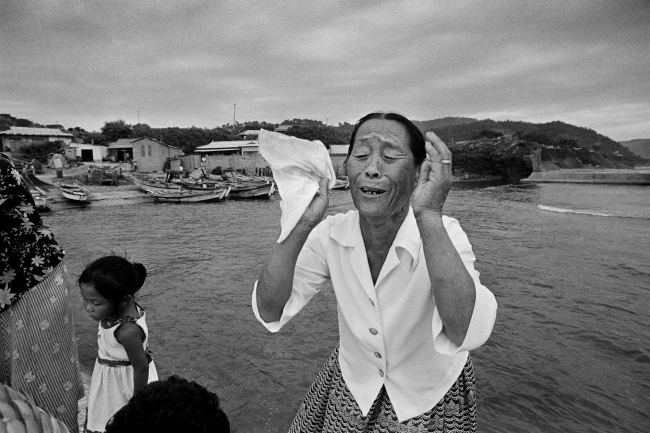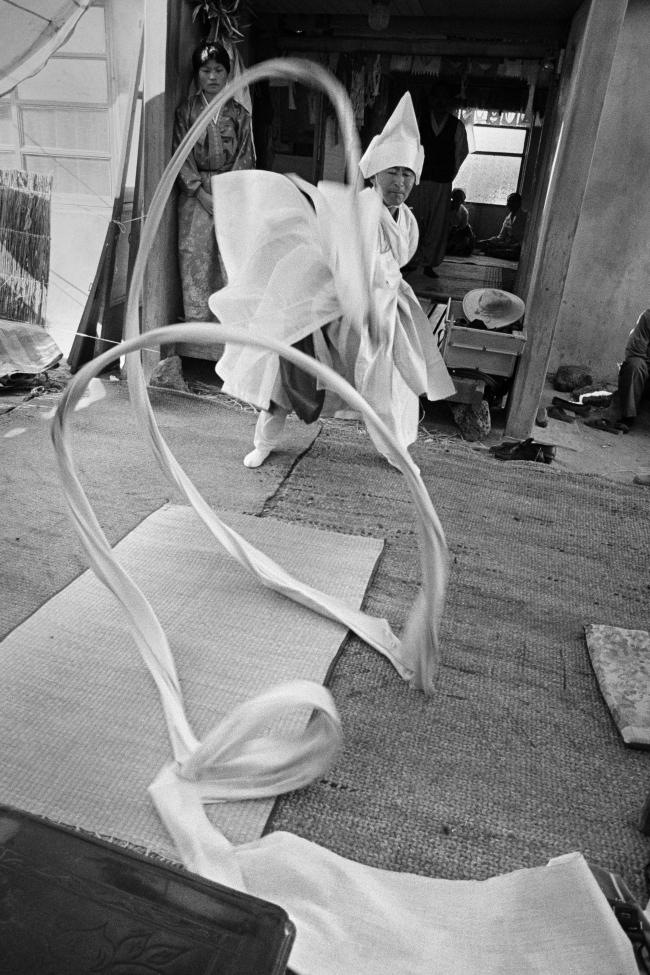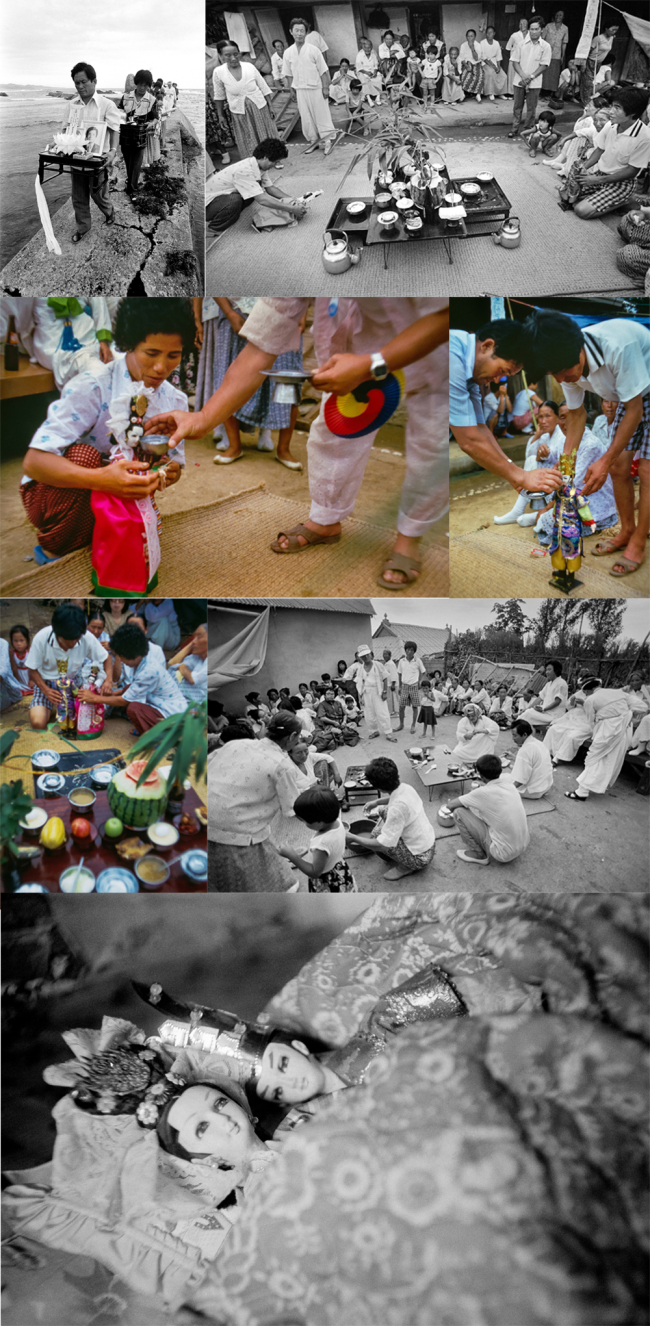Korean shamanic ritual documented in photography
Exhibition highlights photographs of ‘gut’ by Kim Soo-nam and his lifelong dedication to capturing the fading tradition
By KH디지털2Published : April 6, 2016 - 17:01
Rare photographs that offer a glimpse of shamanic rituals and ceremonies in Korea are currently on view at the National Folk Museum of Korea.
The exhibition features some 100 photographs, taken by the late Kim Soo-nam, a photojournalist who devoted more than 30 years to documenting scenes of shamanic rituals in Korea and other Asian countries. The photos reveal scenes of 22 major shamanic rituals that were or have long been practiced in Korea.
The photos were culled from a vast archive of some 170,000 photographs Kim’s family had donated to the museum in 2015. Kim died of brain hemorrhage while photographing a shamanic ritual in Chiang Rai, Thailand in 2006.
“Kim started taking pictures of shamanic rituals around Korea since the early 1970s when he began working as a photojournalist at Donga Ilbo after graduating college. He started documenting shamans and their practices with a sense of urgency, as he felt that soon they would no longer be in practice,” said Kim Hyeong-ju, curator of the exhibition, at the press preview on Tuesday.
Starting in the 1970s, amid rapid industrialization and modernization, Korean shamanism underwent a period of oppression. In fact, during the rule of successive authoritarian governments in the 1970s and 1980s, shamans and their clients were often arrested.
The exhibition features some 100 photographs, taken by the late Kim Soo-nam, a photojournalist who devoted more than 30 years to documenting scenes of shamanic rituals in Korea and other Asian countries. The photos reveal scenes of 22 major shamanic rituals that were or have long been practiced in Korea.
The photos were culled from a vast archive of some 170,000 photographs Kim’s family had donated to the museum in 2015. Kim died of brain hemorrhage while photographing a shamanic ritual in Chiang Rai, Thailand in 2006.
“Kim started taking pictures of shamanic rituals around Korea since the early 1970s when he began working as a photojournalist at Donga Ilbo after graduating college. He started documenting shamans and their practices with a sense of urgency, as he felt that soon they would no longer be in practice,” said Kim Hyeong-ju, curator of the exhibition, at the press preview on Tuesday.
Starting in the 1970s, amid rapid industrialization and modernization, Korean shamanism underwent a period of oppression. In fact, during the rule of successive authoritarian governments in the 1970s and 1980s, shamans and their clients were often arrested.

Kim, then a photojournalist at Donga Ilbo, felt a sense of responsibility to record the declining and neglected Korean tradition that had emerged in prehistoric times.
“It’s for sure that the Dodang-gut (ritual) practiced in the southern Hangang River will disappear in a few years. When the shamans die, it’s the end. I feel lucky to have photographed those who have aged along with their practice for 60 to 70 years,” wrote Kim, in a research note in 1982.
The exhibition highlights the two most common reasons among Koreans for holding shamanic rituals -- to console the dead, and to wish good fortune for the living. The exhibition also displays snapshots of shamans and the mix of emotions that play across their faces during the shamanic rituals that they presided over.
The first section, “Beginning of Life,” displays photographs Kim took during shamanic rituals often held in port towns for fishermen who died in storms at sea. Shamans hold a ritual to retrieve their souls and send them on their way to heaven.
Kim said he felt that shamanic rituals are held, not just for the dead, but perhaps more for the family members left behind who are trying to find solace.
“Death is regarded as the starting point of a new life, since the living has to overcome sorrow and gain strength to carry on with their life (after the ritual). The dead completes earthly lives and reach a transition point where they enter into the afterlife. After all the steps of comforting, bidding farewell and healing are completed, death becomes the beginning of life, not the end,” Kim said in an interview with a Jeju broadcaster in 1999.
The families of unmarried fishermen often request a shaman to preside over a spiritual wedding between their son and another deceased, unmarried woman in their town. The wedding looks like a typical traditional Korean wedding, with the only difference being that the bride and groom are substituted by dolls dressed in wedding costumes.

“It’s not different from an ordinary wedding. After the wedding, both families become in-laws and keep in touch,” said the curator.
Kim was not just an observer in the shamanic rituals. He sometimes put down his camera, and ate and drank with the shamans and families to understand their pain and feelings.
“In the beginning, he was completely restricted from entering shamanic rituals. He was an outsider with no right to capture whatever was happening on the scene. Kim tried to build what’s called ‘rapport’ in the field of folklore studies,” said the curator.
Many shamanic rituals in Korea have been held to wish for good life, prosperity, fecundity and longevity. For folklore scholars, Kim’s photographs are a valuable resource for the study of Korean shamanism.
Starting in 1988, Kim captured shamanic rituals in other parts of Asia, traveling to 11 countries to record the shamanic rituals of more than 40 ethnic Asian groups. The exhibition includes several photos of shamanic rituals in Japan, China, Indonesia, Myanmar and other countries. They bear striking resemblance to many of Korean shamanic rituals.
The exhibition runs until June 6 at the National Folk Museum of Korea. For more information, visit www.nfm.go.kr.
By Lee Woo-young (wylee@heraldcorp.com)
A shamanic spiritual wedding held in Pohang, North Gyeongsang Province, in 1981

From left to right, top to bottom:
1. Family members of the deceased visit the sea where the groom died before the spirit wedding.
2. Family members conduct a spiritual wedding for the deceased bride and groom under the guidance of a shaman.
3. A female doll represents the bride.
4. A male doll represents the groom.
5. The bride and groom stand together before the wedding table.
6. A wedding reception is held following the spiritual wedding.
7. The bride and groom spend the first night together.
(Photographs by Kim Soo-nam/The National Folk Museum of Korea)








![[Today’s K-pop] BTS pop-up event to come to Seoul](http://res.heraldm.com/phpwas/restmb_idxmake.php?idx=644&simg=/content/image/2024/04/17/20240417050734_0.jpg&u=)

![[Graphic News] More Koreans say they plan long-distance trips this year](http://res.heraldm.com/phpwas/restmb_idxmake.php?idx=644&simg=/content/image/2024/04/17/20240417050828_0.gif&u=)





![[KH Explains] Hyundai's full hybrid edge to pay off amid slow transition to pure EVs](http://res.heraldm.com/phpwas/restmb_idxmake.php?idx=652&simg=/content/image/2024/04/18/20240418050645_0.jpg&u=20240419100350)

